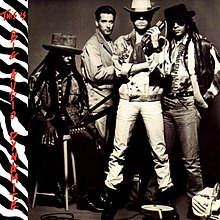| This Is Big Audio Dynamite | ||||
|---|---|---|---|---|
 | ||||
| Studio album by | ||||
| Released | 1 November 1985[1] | |||
| Studio |
| |||
| Genre | ||||
| Length | 43:09 | |||
| Label | Columbia | |||
| Producer | Mick Jones | |||
| Big Audio Dynamite chronology | ||||
| ||||
| Singles from This is Big Audio Dynamite | ||||
| ||||
| Review scores | |
|---|---|
| Source | Rating |
| AllMusic | |
| Christgau's Record Guide | B−[4] |
| The Encyclopedia of Popular Music | |
| The Great Rock Discography | 7/10[6] |
| Mojo | |
| MusicHound | 4/5[8] |
| PopMatters | 7/10[9] |
| Record Mirror | 4/5[10] |
| The Rolling Stone Album Guide | |
| Smash Hits | 7/10[12] |
This Is Big Audio Dynamite is the debut studio album by the English band Big Audio Dynamite, led by Mick Jones, the former lead guitarist and co-lead vocalist of the Clash. It was released on 1 November 1985 by Columbia Records. The album peaked at No. 27 on the UK Albums Chart and at No. 103 on the Billboard 200, and was certified gold by the British Phonographic Industry (BPI). Three singles were released from the album, all of which charted in the UK. "The Bottom Line" released a month before the album, barely made the Top 100, peaking at No. 97, becoming their lowest charting single, whereas its follow-up single "E=MC²" released in 1986, became their only Top 20 hit, peaking at No. 11, and becoming their best-selling single. The final single from the album, "Medicine Show" also released in 1986, became their last single to chart within the Top 40 under the original line-up, peaking at No. 29. The music video for "Medicine Show", directed by Don Letts, featured two other former members of the Clash, Joe Strummer and Paul Simonon as police officers as well as John Lydon of the Sex Pistols and Public Image Ltd.
A remastered Legacy Edition was released in 2010 with a second disc composed of alternate mixes and versions. In 2016, independent vinyl reissue label Intervention Records reissued the album on 180-gram vinyl.[13]
- ^ "News Digest" (PDF). Record Mirror. 26 October 1985. p. 37. Retrieved 6 October 2022.
- ^ a b c Erlewine, Stephen Thomas. Review: This Is Big Audio Dynamite. AllMusic. Retrieved on 2010-04-09.
- ^ "Big Audio Dynamite – The Bottom Line".
- ^ Christgau, Robert (1990). "B". Christgau's Record Guide: The '80s. Pantheon Books. ISBN 0-679-73015-X. Retrieved 17 August 2020 – via robertchristgau.com.
- ^ Larkin, Colin (2011). "Big Audio Dynamite". Encyclopedia of Popular Music. Omnibus Press. ISBN 9780857125958.
- ^ Strong, Martin C. (2004). "Big Audio Dynamite". The Great Rock Discography (7th ed.). Canongate Books. p. 133. ISBN 1-84195-615-5.
- ^ Ian Harrison Mojo, June 2010.
- ^ Graff, Gary; Durchholz, Daniel, eds. (1999). "Big Audio Dynamite". MusicHound Rock: The Essential Album Guide. Visible Ink Press. p. 102. ISBN 1-57859-061-2.
- ^ Fairall, Jer (10 June 2010). "Big Audio Dynamite: This Is Big Audio Dynamite (Legacy Edition)". PopMatters. Retrieved 13 August 2024.
- ^ Reid, Jim (16 November 1985). "Big Audio Dynamite: This Is Big Audio Dynamite". Record Mirror. Vol. 32, no. 46. Retrieved 13 August 2024.
- ^ Considine, J. D. (2004). "Big Audio Dynamite". In Brackett, Nathan; Hoard, Christian (eds.). The New Rolling Stone Album Guide (4th ed.). Simon & Schuster. p. 69. ISBN 0-7432-0169-8.
- ^ White, William (20 November 1985). "Albums Review". Smash Hits. No. 182. Retrieved 13 August 2024.
- ^ "This Is Big Audio Dynamite 180G LP – Intervention Records". interventionrecords.com. Retrieved 16 May 2018.